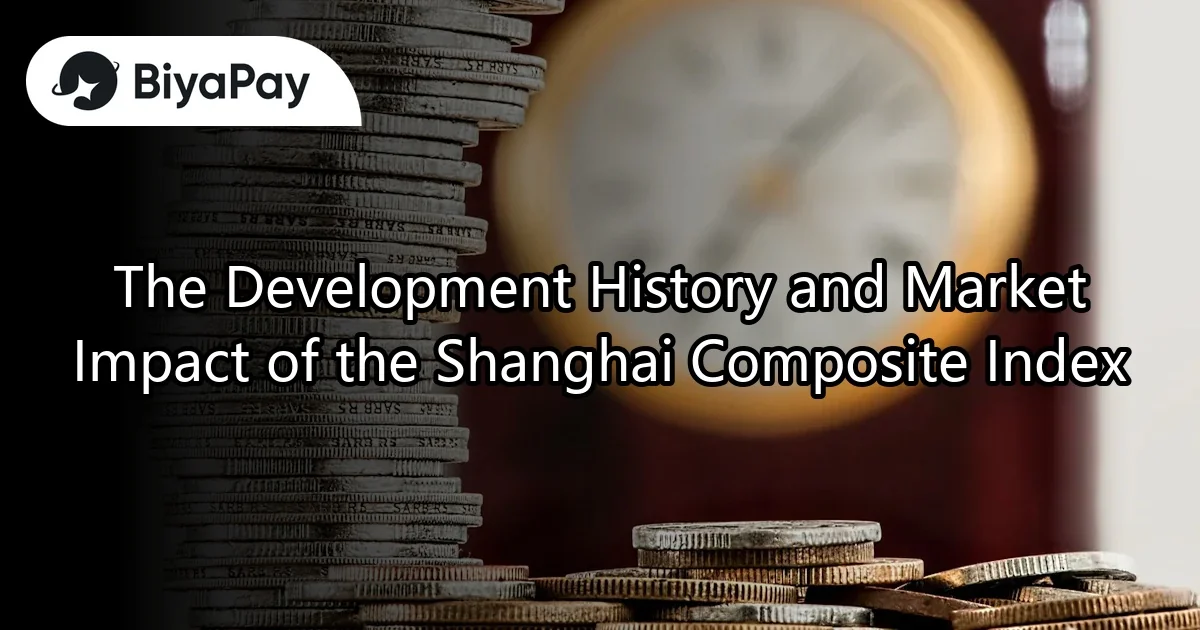- EasyCard
- Trade
- Help
- Announcement
- Academy
- SWIFT Code
- Iban Number
- Referral
- Customer Service
- Blog
- Creator
The Development History and Market Impact of the Shanghai Composite Index

Image Source: pexels
The Shanghai Composite Index plays a pivotal role in China’s financial market. It covers most stocks listed on the Shanghai Stock Exchange, reflecting the overall market trend. Investors and analysts often use this index to gauge economic health and market sentiment. As a market indicator, it not only influences domestic investment decisions but also attracts the attention of international capital. The index’s fluctuations can reveal policy impacts and corporate performance, serving as a vital reference tool for market participants.
Key Points
- The Shanghai Composite Index, launched in 1991, has become a key indicator of China’s capital market, reflecting overall market trends.
- The index’s fluctuations can reveal economic health, enabling investors to adjust strategies and enhance return opportunities.
- With the globalization process, the index has attracted international capital, promoting market diversification and increasing its global influence.
- Market volatility is a major characteristic of the Shanghai Composite Index, and investors should remain rational, avoiding overreactions to short-term fluctuations.
- In the future, the index needs to adjust its constituent stock structure more flexibly to accurately reflect emerging industries’ development and improve transparency and efficiency.
Historical Development of the Shanghai Composite Index

Image Source: pexels
Initial Stage and Background of Its Creation
The Shanghai Composite Index was officially launched on December 19, 1991, marking a significant step toward the modernization of China’s capital market. At that time, the Shanghai Stock Exchange had just been established, with a small market scale and only a few dozen listed companies. The index was designed to reflect the overall market performance, providing investors with a tool to measure market trends. This stage was characterized by the establishment of market infrastructure and the exploration of standardized operations.
At the time, China’s economy was in the early stages of reform and opening-up, and the development of the capital market was still a nascent field. The launch of the Shanghai Composite Index provided market participants with a transparent reference standard and attracted more investor attention. The creation of this index laid the foundation for subsequent market development.
Growth and Policy Adjustments
Entering the 21st century, the Shanghai Composite Index experienced a phase of rapid growth. The Chinese government introduced multiple policies to support capital market development, including an increase in the number of listed companies and market scale expansion. Between 2005 and 2007, the total market capitalization grew from 3 trillion yuan to 30 trillion yuan, achieving a tenfold increase. This period of rapid development reflected China’s high economic growth and the vibrancy of its capital market.
However, the rapid market expansion also brought challenges, such as increased stock market volatility and irrational investor behavior. To address these issues, regulatory authorities implemented several measures, including strengthening market oversight and promoting improvements in corporate governance structures of listed companies. These policy adjustments further enhanced market stability and transparency.
| Year | Total Market Capitalization (Trillion Yuan) | Growth Multiple |
|---|---|---|
| 2005 | 3 | - |
| 2007 | 30 | 10x |
Globalization and Market Reforms
With the globalization of China’s economy, the Shanghai Composite Index gradually became a focal point for international investors. The Chinese government promoted the opening of the capital market, including the introduction of the Qualified Foreign Institutional Investor (QFII) system and the Shanghai-Hong Kong Stock Connect mechanism, facilitating international capital’s entry into the Chinese market. These reforms further enhanced the global influence of the Shanghai Composite Index.
Additionally, the index’s compilation methodology was adjusted to meet market demands. For example, the selection of constituent stocks placed greater emphasis on industry representation and market liquidity, ensuring the index accurately reflected overall market performance. These reforms not only improved the index’s scientific rigor but also strengthened its value as a market reference tool.
The globalization process of the Shanghai Composite Index brought more opportunities and challenges to China’s capital market. The inflow of international capital promoted market diversification but also placed higher demands on market stability.
Volatility and Innovation
Throughout the development of the Shanghai Composite Index, market volatility has been an undeniable characteristic. Particularly during the 2008 global financial crisis, the index experienced sharp declines. This event highlighted the interconnectedness of China’s capital market with global markets. At the time, investor confidence was severely shaken, and market trading volumes significantly contracted. Such volatility not only affected investor behavior but also prompted regulatory authorities to strengthen market monitoring.
Innovation became a key approach to addressing volatility. The Chinese government and market participants actively promoted the diversification of financial instruments, such as introducing stock index futures and ETFs (exchange-traded funds). These innovative tools provided investors with more risk management options while enhancing market liquidity. For example, ETFs, with their simple structure and low transaction costs, attracted significant participation from small and medium-sized investors.
Moreover, technological advancements supported innovation in the Shanghai Composite Index. The application of big data and artificial intelligence technologies helped analysts predict market trends more accurately. The introduction of these technologies not only improved market efficiency but also provided investors with a more transparent information environment.
Tip: While innovation can mitigate market volatility, investors should remain rational and avoid over-relying on new tools.
Modernization Challenges
As the global economic environment evolves, the Shanghai Composite Index faces multiple modernization challenges. First, the internationalization of the market requires the index to more accurately reflect the diversified structure of China’s economy. This means the index needs to include more emerging industries, such as new energy and technology sectors. The rapid development of these industries places higher demands on the selection of constituent stocks.
Second, market transparency and regulatory improvements pose another significant challenge. International investors’ trust in the market depends on the stability and enforcement of regulations. To this end, regulatory authorities need to further strengthen oversight of listed companies, ensuring the authenticity of financial statements and the timeliness of information disclosure.
Finally, digital transformation has profoundly impacted the operational model of the Shanghai Composite Index. With the widespread adoption of blockchain technology, the efficiency and security of market transactions have improved. However, digitalization also introduces new risks, such as cybersecurity issues and data privacy protection. These challenges require collaborative efforts from market participants and regulators to address.
Observation: Although modernization challenges are complex, they also provide opportunities for the further development of the Shanghai Composite Index. By addressing these challenges, the index will better serve global investors.
Compilation Logic of the Shanghai Composite Index
Fundamental Design Principles
The compilation of the Shanghai Composite Index adheres to several design principles to ensure it accurately reflects overall market performance. First, the selection of constituent stocks prioritizes market representation. This means the index covers all stocks listed on the Shanghai Stock Exchange, including A-shares and B-shares, providing a comprehensive market perspective. Second, the compilation emphasizes transparency. The compilation authority regularly publishes the index’s calculation methodology and constituent stock list, allowing investors to clearly understand its composition.
Additionally, index stability is a key consideration in its design. To minimize the impact of short-term fluctuations, the compilation authority uses a weighted average method, assigning weights based on market capitalization. This approach ensures that large companies have a more significant influence on the index while reflecting the market’s true state.
Tip: Transparency and stability are cornerstones of index design, helping investors more accurately assess market trends.
Calculation Method and Constituent Adjustments
The Shanghai Composite Index is calculated using a market capitalization-weighted method. The index formula is as follows:
Index = (Total Market Capitalization of Constituent Stocks ÷ Base Period Market Capitalization) × Base Period Index
The market capitalization of constituent stocks is calculated by multiplying the stock price by the number of circulating shares. This calculation method reflects the overall scale and changes in the market. The base period is set as December 19, 1990, with a base index of 100 points.
Constituent stock adjustments are made based on market changes. Every quarter, the compilation authority reviews the constituent stock list, removing stocks that no longer meet standards, such as those with insufficient liquidity or deteriorating financial conditions. Simultaneously, new eligible stocks are added to ensure the index reflects the latest market dynamics.
| Adjustment Frequency | Criteria | Impact |
|---|---|---|
| Quarterly | Liquidity, Market Capitalization | Ensures Index Accuracy |
This dynamic adjustment mechanism ensures the Shanghai Composite Index remains highly consistent with the market, making it an essential reference tool for investors.
Market Impact of the Shanghai Composite Index

Image Source: pexels
Role as a Market Barometer
The Shanghai Composite Index is regarded as a barometer of the Chinese economy, reflecting the overall health of the market. The index’s movements are typically closely correlated with economic indicators, providing investors with important reference points. According to traditional economics, the stock market has predictive functions, capable of foreshadowing future economic trends.
- Before 2009, the stock markets of China and the United States exhibited similar fluctuation cycles.
- An upward trend in the index often signals economic growth, while a downward trend may reflect economic slowdown.
Additionally, the index’s performance can reveal market sentiment. When the index rises steadily, investor confidence is typically high, and capital flows into the market accelerate. Conversely, a falling index may trigger heightened risk aversion, leading funds to shift toward safer assets like gold or the U.S. dollar.
Observation: The barometer role of the Shanghai Composite Index influences not only investors but also provides important references for policymakers.
Impact on Investor Behavior
The fluctuations of the Shanghai Composite Index directly influence investor behavior. When the index rises, investors typically increase their stock investments, expecting higher returns. This behavior can lead to market overheating, further driving up stock prices. However, a falling index may trigger panic selling, exacerbating market volatility.
Investor behavior is also influenced by the index’s structure. For example, the higher weighting of large companies in the index makes investors more likely to focus on their performance. This concentrated investment behavior may lead to uneven capital allocation in the market, affecting the financing capabilities of small and medium-sized enterprises.
Moreover, the transparency and stability of the index affect investor confidence. When the index accurately reflects market conditions, investors are more willing to participate in market trading. Conversely, excessive volatility in the index may undermine investor confidence, leading to capital outflows from the market.
Tip: Investors should remain rational and avoid overreacting to index fluctuations.
Policy Reference Value
The Shanghai Composite Index provides significant reference value for policymakers. The index’s performance reflects the overall health of the market, helping the government assess the effectiveness of economic policies. For example, when the index rises steadily, it may indicate a positive market response to policies and strong economic growth momentum.
Additionally, the index’s volatility can reveal potential market issues. For instance, a sharp decline in the index may reflect insufficient market confidence or economic challenges. The government can adjust policies based on these signals to stabilize the market, such as introducing stimulus measures or strengthening oversight to reduce market uncertainty.
The internationalization of the index has also enhanced its policy reference value. With the inflow of international capital, the index’s performance reflects global investor confidence in the Chinese market. This provides important guidance for the government in formulating opening-up policies.
Observation: The policy reference value of the Shanghai Composite Index extends beyond the economic sphere, influencing the stability of the financial market.
The historical development of the Shanghai Composite Index showcases the growth and transformation of China’s capital market. From the infrastructure-building phase in its early days to the advancement of globalization, the index not only reflects overall market performance but also serves as a key indicator of economic health. Its transparency and stability provide investors with a reliable reference tool and hold guiding significance for policymakers.
In the future, the development direction of the Shanghai Composite Index may focus on enhancing industry representation and technological applications. With the rise of new energy and technology sectors, the index needs to adjust its constituent stock structure more flexibly to accurately reflect economic diversification trends. Additionally, the application of leading indicators like PMI will further assist market participants in forecasting economic conditions and A-share trends, supporting investment decisions.
Observation: The further modernization and internationalization of the Shanghai Composite Index will create more opportunities for global investors and solidify its position as a market indicator.
FAQ
1. How Does the Shanghai Composite Index Differ from Other Indices?
The Shanghai Composite Index covers all stocks listed on the Shanghai Stock Exchange, including A-shares and B-shares, reflecting overall market performance. In contrast, other indices like the Hang Seng Index or Dow Jones Industrial Average typically select only a subset of representative stocks as constituents.
Tip: The Shanghai Composite Index is more comprehensive but may exhibit higher volatility.
2. How Can Investors Use the Shanghai Composite Index for Decision-Making?
Investors can observe the index’s trends to understand market sentiment and economic health. A rising index may indicate growing market confidence, while a falling index may signal increased risks.
Suggestion: Investors should combine the index with other economic indicators and avoid relying solely on it.
3. How Are the Constituent Stocks of the Shanghai Composite Index Adjusted?
The index’s constituent stocks are adjusted quarterly. The compilation authority removes stocks with insufficient liquidity or poor financial conditions and adds eligible stocks to ensure the index reflects the latest market dynamics.
Observation: The dynamic adjustment mechanism enhances the index’s accuracy and representation.
4. Is the Shanghai Composite Index Suitable for International Investors?
The Shanghai Composite Index holds reference value for international investors, particularly in the context of China’s economic globalization. Through mechanisms like the Shanghai-Hong Kong Stock Connect, international capital can directly participate in the Chinese market.
Note: International investors should pay attention to exchange rate fluctuations and policy changes.
5. What Is the Future Development Direction of the Shanghai Composite Index?
In the future, the index may place greater emphasis on representing emerging industries like new energy and technology. Additionally, the application of digital technologies will enhance the index’s transparency and efficiency, attracting more international capital.
Outlook: The modernization and internationalization of the index will further strengthen its market influence.
The SSE Composite Index, a barometer of China’s capital market, highlights opportunities in market volatility and global investment, and an efficient, low-cost financial platform can help you navigate global market dynamics. BiyaPay offers a streamlined financial solution, enabling trading in U.S. and Hong Kong stocks without offshore accounts, allowing you to participate in the market cost-effectively, whether seizing short-term opportunities in Hong Kong stocks linked to SSE index volatility or investing long-term in Hong Kong markets for stable returns.
Its platform supports USD, HKD, and 30+ fiat and digital currencies with real-time exchange rate insights, helping you manage exchange rate risks in cross-border investments while maintaining investment efficiency. With remittance fees as low as 0.5% across 190+ countries, it simplifies fund allocation without high costs eroding profits. A flexible 5.48% annualized yield savings product with no lock-in period ensures idle funds grow during market volatility or while awaiting investment opportunities, seamlessly aligning with global market strategies. Sign up for BiyaPay today to leverage SSE Composite Index insights with BiyaPay’s versatile tools for an efficient, stable global investment journey!
*This article is provided for general information purposes and does not constitute legal, tax or other professional advice from BiyaPay or its subsidiaries and its affiliates, and it is not intended as a substitute for obtaining advice from a financial advisor or any other professional.
We make no representations, warranties or warranties, express or implied, as to the accuracy, completeness or timeliness of the contents of this publication.




Contact Us
Company and Team
BiyaPay Products
Customer Services
is a broker-dealer registered with the U.S. Securities and Exchange Commission (SEC) (No.: 802-127417), member of the Financial Industry Regulatory Authority (FINRA) (CRD: 325027), member of the Securities Investor Protection Corporation (SIPC), and regulated by FINRA and SEC.
registered with the US Financial Crimes Enforcement Network (FinCEN), as a Money Services Business (MSB), registration number: 31000218637349, and regulated by FinCEN.
registered as Financial Service Provider (FSP number: FSP1007221) in New Zealand, and is a member of the Financial Dispute Resolution Scheme, a New Zealand independent dispute resolution service provider.



















